We all know how easy it is to get tied up in complicated swing theory – but there’s no arguing with sport science when it comes to identifying the critical concepts of athletic balance, efficiency of human motion and the dynamics that must exist in order to optimise the chain of kinetic energy which, ultimately, determines success in golf. And for many of the world’s top professionals –Matteo Manassero and Justin Rose among them – the work of biomechanics coach Jean-Jacque Rivet, based at the magnificent Terre Blanche Hotel Spa Golf Resort, 40 minutes from Nice, provides the energising link between theory and practice – insight that every golfer needs to improve his or her body action
By Jean-Jacques Rivet Head of Under armour innovation centre for Europe
Article 1 in this mini series – Le Swing Dynamic
Article 2 in this mini series – Work That Body
Article 3 in this mini series – Ground Control
My interest in sport science began in the early 1980s when I called time on my water polo career and enlisted at the School of Rehabilitation & Physiotherapy at the University of Montpellier, where I discovered some crazy people who opened my eyes to the capabilities of biomechanics. through the university I was introduced to the work of Dr Gideon Ariel in the US, a former olympic athlete and a true pioneer in the study of applied biomechanics – Ariel invented the first computerised system to accurately measure an athletes’ movement according to Newton’s laws of motion. I have been fortunate to have spent time with him to appreciate the physical capabilities of the human body and understand the principles top athletes follow in training to optimise performance in their chosen sport.
The third significant influence on my career has been none other than David Leadbetter, perhaps the most forward-thinking teacher the game has known.
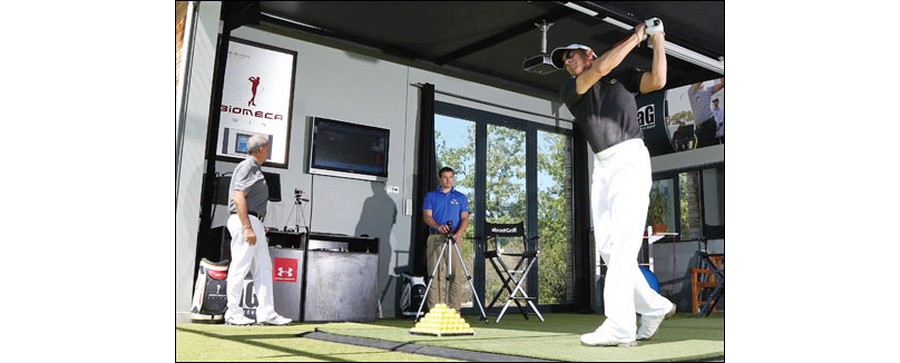
Readers of Golf International will not need reminding of David’s credentials, but I think it is testament to his professionalism that in 1998, at the pinnacle of his career, he invited me to his base in Florida to help him explore the concepts of biomechanics as they relate to the golf swing. David wanted to explore every angle in his quest to understand how the body works and, over the time i have known him, his knowledge in the law of human mechanics and how they relate to the golf swing has never ceased to impress. So, on the range with ‘Lead’ is where my love of golf began, and my education continued off the course as I was treated to a masterclass in the study of the golf swing through the ages – David’s has one of the world’s finest collections of classic instruction books. My eyes were opened to all of the different techniques observed in the great players of each generation – from Bobby Jones, to Ben Hogan, Jack Nicklaus, Nick Faldo and Tiger Woods.
It was an invaluable learning experience and the association that we have today with a Leadbetter Academy here at Terre Blanche, has been key to our success in integrating the study of biomechanics into the training programmes that we offer.
Efficiency of motion: identifying the most simple, repetitive movement that enables a player to return the clubface at speed squarely to the ball has been the key to David’s teaching philosophy his entire career. And this is where the science of biomechanics gets interesting. In the course of our research, I have been able to use my skills in the area of human physiology to answer certain questions about the body in motion which have helped David to identify certain elements in the swing that characterise the modern blueprint. It all boils down to understanding ‘dynamic balance’ and synchronising the movement of the club with the body to maintain that balance from start to finish – the principles of which I am now going to share with you.
When you look back at David’s ground-breaking book The Golf Swing, it is remarkable how his own visualisation of the simple, efficient swing resembles that which biomechanics now confirms to be the correct technique based on study of human motion. What we do here at the Albatros Performance Centre at Terre Blanche (and in association with the first European Tour Performance Institute – ETPI) is fine-tune a player’s understanding of athletic balance, weight distribution, optimising the centre of gravity, generating speed through core rotation, and so on, with the benefit of being able to measure precisely all of the key numbers and parameters. And as a result we can then devise training programmes that enable a golfer to focus on improving in those areas that are holding him back.
Essentially, the series of articles that I am going to present in Gi is focused on how the mechanics of the club can be optimised by the natural and simple mechanic of the body. Simplicity brings you to efficiency – if a swing is difficult to coordinate, it is difficult to repeat. The key is that you have to learn to move the club in ‘sync’ with the body – and all of the drills and exercises that I will introduce over the course of the next few issues are designed to help you improve the muscle memory that gives you the opportunity to repeat a good swing automatically on the golf course.
Naturally, it all stems from the posture. Everything in the golf swing has its origins here – the kinematic muscle chain works up from the feet, to sustain posture and balance.
Posture, balance & grounding
Before we go any further, let me introduce our student, Morgan Mason, son of the legendary British screen actor James and a 4-handicap founder member here at Terre Blanche. By any standards, Morgan is pretty fit and flexible for a guy in his mid 50s, and in the time we have been working together his understanding of biomechanics has enabled him to improve his golf year on year.
One of the most important areas we keep coming back to is the dynamic of the set-up position, and, specifically, the feelings associated with an athletic ‘ready’ posture. One of the most common set-up faults that we see in the players we work with here at the Albatros Performance Centre is a tendency to position too much weight on the front of the feet at the set-up, which upsets the centre of gravity and has a negative influence on the coordination of the arms and the body during the swing. To get around that problem, a favourite exercise is to use two halves of a tennis ball, placing them on the ground in a manner that allows the player to set up with the left toe and right heel on top of each ball, as Morgan is doing.

For anyone guilty of tipping too far forward at the set-up, their weight predominantly on the toes, this drill will reinforce the feeling that you need to be looking for here, engaging the muscles in the calves and thighs in order to support the upper body, to optimise the centre of gravity in the middle of the feet at address, and set in train the natural kinematic sequence from the word ‘go’.
The real beauty is that you feel it: as you settle into position, you want to apply pressure to both hemispheres, keeping your feet grounded.
This will have the effect of gearing up the muscles in the knees and thighs to create a dynamic posture – one that will enhance your ability to control and work with your centre of gravity. With that sensation in the lower half of your body, you will find that working from this stance encourages you to work the arms and body together as you initiate the backswing sequence.
One of the bedrocks of David’s teaching is that one good move leads to another – a dynamic golf swing is a chain reaction. And the reason this drill is so effective is that the grounded set-up position it gives you leads to the first move you see Morgan making here above, the arms and the club working with the torso to initiate momentum. What you find is that maintaining the pressure on the hemispheres helps your lower body to work correctly, the hips resisting here as the arms and trunk get the swig in motion. The hands are passive. The first link in the chain, if you like.
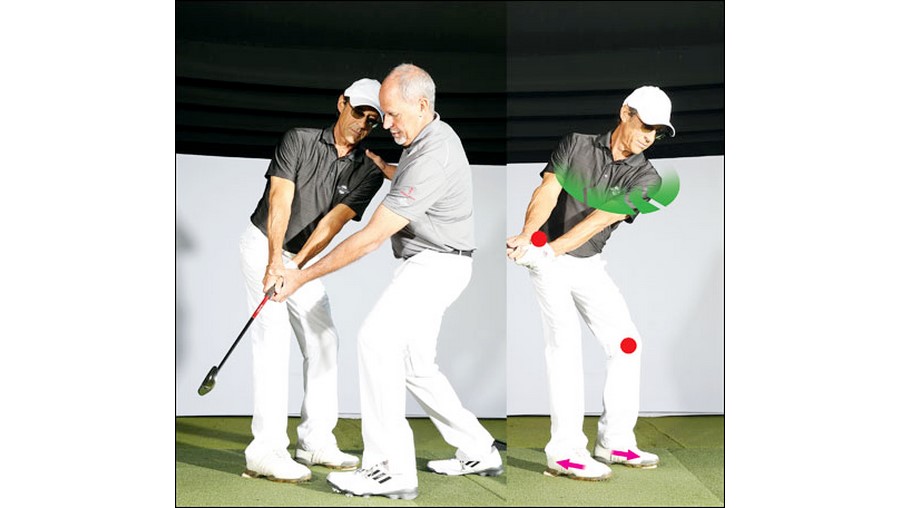
It all comes back to the skeleton, how the individual muscles relate to each other and work together to optimise the strength in the whole body, not just in one specific area. Footwork is a vital component of every athletic motion – and that includes the golf swing. Through the repetition of this drill, Morgan has grooved the first move in his backswing to the point where it becomes automatic – laying the foundation for the core to rotate and compress correctly as he continues to turn his upper body against the hips.
Of course, the secret to applied biomechanics is that all of the important parameters can be measured, and the AboutGolf forceplate that we have built in to the mat in our studio provides valuable data, such as the distribution of weight along the axis of the foot (The Hendrix Torsion Bar), the behaviour of the centre of gravity, and the relative weight shift from left to right. The muscular chain starts through the feet and every single part of the body is connected. What you do at the set up is designed to help you access the centre of gravity in your golf swing – and to remain on that track, synchronising the movement of the arms with the body. As David [Leadbetter] always stresses in his coaching, you have to take care of all of these basic body conditions to avoid sloppy mistakes.
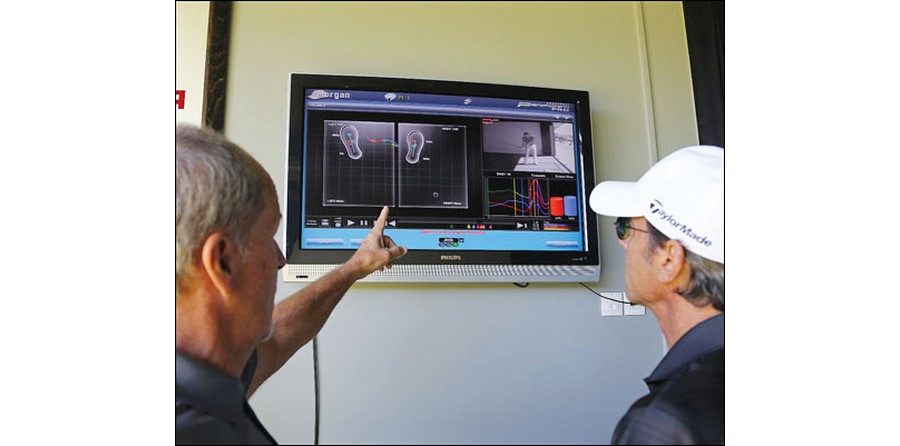
Keep club & body ‘in sync’
The temptation to manipulate the position of the club with the hands during the early stages of the swing is one that too many golfers find hard to resist (pros included!). Having initiated the sequence with a good moveaway (as per the previous pages), Morgan is now working on a drill that we use to check that the club and the body are working together in sync, and in balance, en route to the top of the backswing.
The vital point I must stress here is that the quality of the foot, leg and hip action allows the player to maintain his spine angle and focus on marrying the swinging of the arms with the mechanic of the club. And a simple checkpoint you can use is to swing the club to this halfway position, then take your left hand off the grip and feel the weight of the club in your right hand. It should feel very light in your hand – it’s in balance. Work through the stages as Morgan has: the first move sees the clubhead remain outside the hands before the wrists then hinge up to ‘set’ the club on plane and in balance. In front of a full-length mirror, look for the rotation of the core and shoulders, which allows the arms to swing inside the ball to target line; in so doing, the direction in which the club is swinging mirrors the direction in which the centre of gravity is travelling (and that’s one of the key factors to optimising power and efficiency).
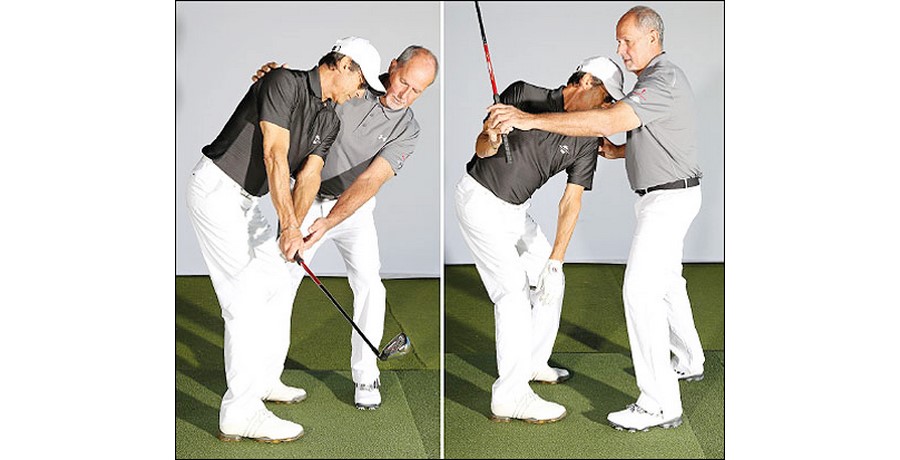
In consultation with a player’s coach, we generally look for the angle of the shaft to be just short of the vertical (too flat and it will feel heavy in your hand). I notice that Nick Faldo refers to this little drill in his book A Swing for Life, and many of the tour players we work with use it to promote the harmony of arms, club and body. If you hold a club lightly between the right thumb and forefinger, it will find its own balance point as you swing it up to this position. Get into a good posture, and rehearse this until it becomes automatic.

One more thing: in the above photo, you can see that Morgan has curled up the toes on his right foot. That’s a good training tip to help a player maintain the grounding of the right foot and encourage the weight to travel toward the right heel during the backswing (the correct alignment of the feet/knees, the posture and hip action can all be improved with the fitting of insoles into the shoe – more on that in a future issue.)
Rotation of left forearm & shoulder
Harmonising the movement of the arms with the torso is one of the most important elements of the swing good players focus on to improve the consistency of their action – and here’s another great exercise that is easy to do at home or on the range. You often hear a coach talk about the left arm ‘swinging across the chest’ during the initial stages of the swing, and that’s exactly what this will help you to experience. (What you don’t want is an independent hand/arm action where the left arm works out and away from the body, nor do you want it to be dragged in so tight across your chest that it gets behind you).
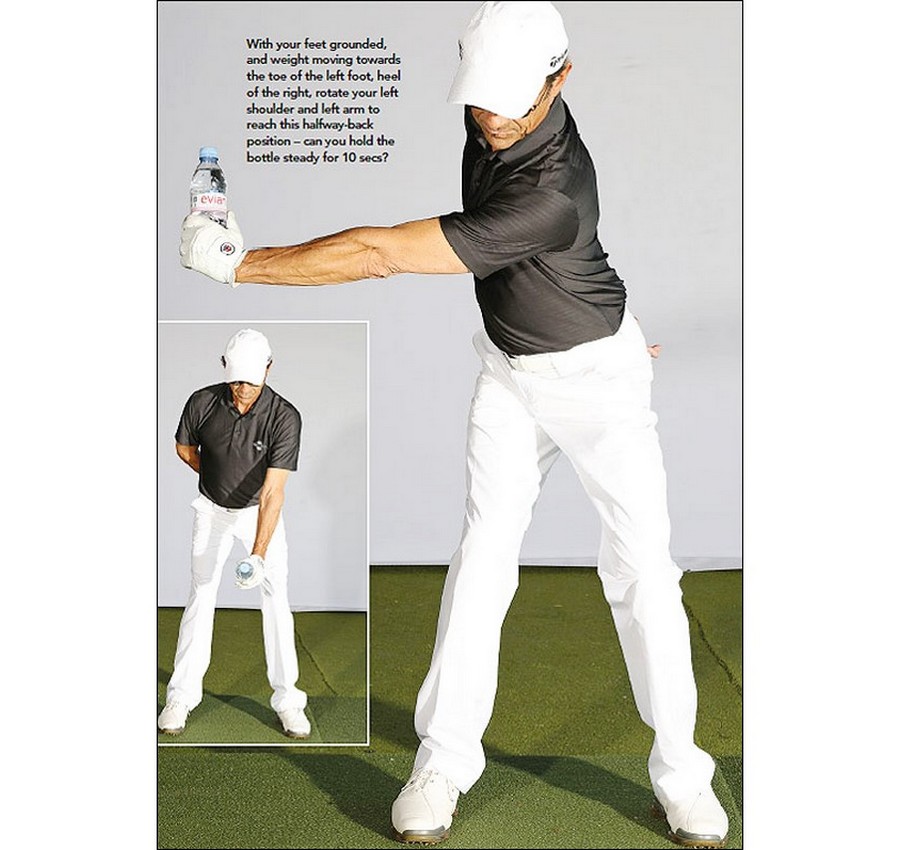
The drill you see Morgan rehearsing here is one we use to determine a player’s strength in the left shoulder/left forearm area. Specifically, we are looking for the left arm to maintain its natural relationship with the rotating torso as a player makes this move to halfway. And while it may not sound all that difficult, holding a 500ml bottle of water in your left hand – and holding this rotated position for 10 seconds or so – is actually harder than it looks.
(Note: If you find it difficult to keep the elbow ‘comfortably’ straight, and the water is shaking all over the place, it could be that a shoulder problem is holding you back – consult your physiotherapist.)

The key to this exercise is that you take care of all the posture angles at the set up and think about your weight distribution and the direction in which your weight travels as you rehearse this move over and over. The big mistake is to bend or flex the elbow – a problem that usually stems from a reluctance to turn the torso correctly. So think about the rotation of your left shoulder over the resistance of the hips, and let your left arm find its natural position. The gym exercise you see here is just one example of the type of golf-specific work-outs we devise to help a player target areas of weakness – and we’ll have more of the same in the next issue.
The kinetic chain of motion – balance, resistance, coil, power
Layering the moves one on top of another, allowing the chain reaction to flow, let’s now look at the full progression of the backswing and the all-important transition into the downswing – for many amateur golfers one of the most problematic of all areas.
Again, from a good set-up position, the key is that we’re looking for a resistance in the left knee and right hip as the upper body rotates to initiate the backswing. This dynamic resistance in the lower body is what creates the ‘coil’ in a good backswing – and Morgan really nails this first move; the left knee works toward the toe of the left foot (following what is known anatomically as the Hendrix Bar, the heel-to-toe axis in the foot), while the direction in which the right hip travels mirrors the flow of weight towards the heel in the right foot.
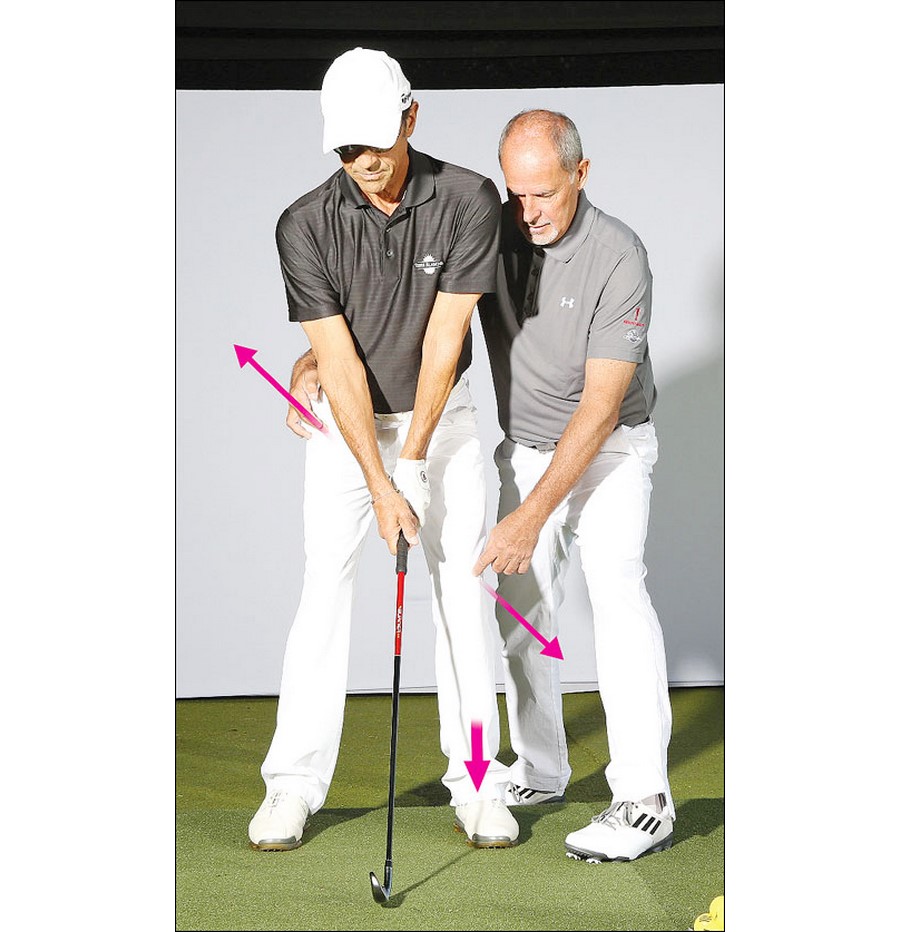
You can see (in the second frame in the sequence) that Morgan is swinging his arms nicely to the inside, and that they are working in sync with the rotation of his torso. The key point to understand here that the momentum of his swing matches up with the flow of weight into that right heel; the dynamics complement one another. You will not enjoy this controlled harmony of movement if the hands, arms and the club are detached from the rotation of the torso (i.e. working independently, either outside or too far inside the play line).
Grabbing Morgan’s left hip pocket while at the same time pushing on his left shoulder sets up the conditions for the dissociation of the hips and the shoulders – a key physical element in every good golf swing, one that is vital to maximising the energy in the recoil. The idea here is simply that through experiencing the feeling with a bit of gentle persuasion, Morgan will then be able to replicate it without my help – the feel makes it real.
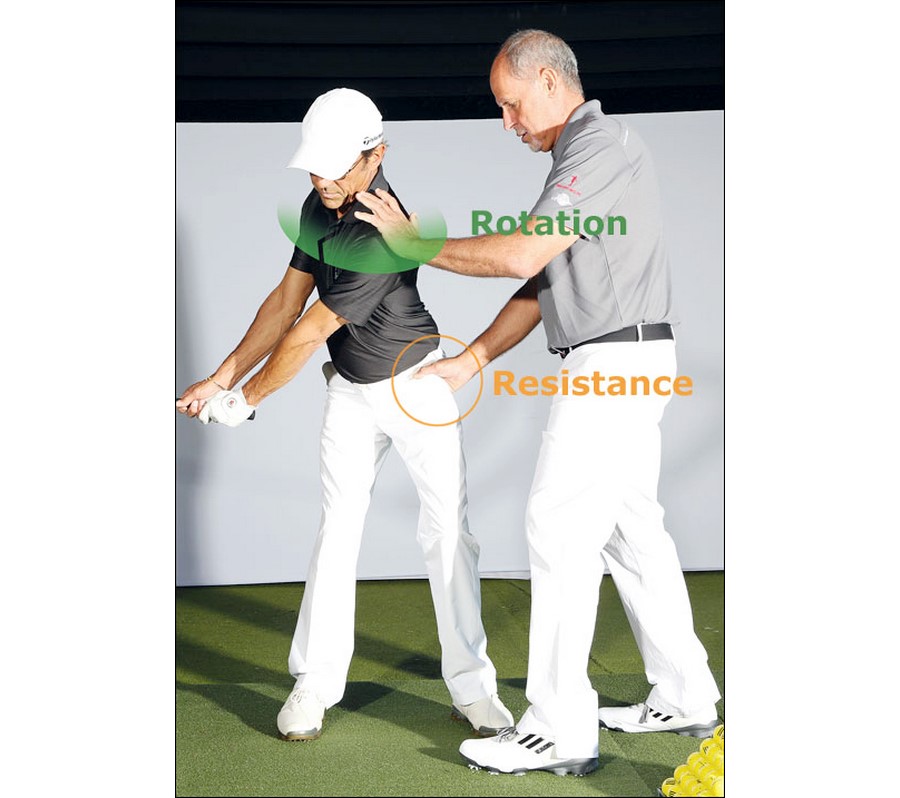
As he nears the top of his backswing (frame 3), he’s really loading into a great position. The feet have remained ‘grounded’, and his lower body is providing not only the balance but the key resistance to the rotation of the trunk. This is a compact, controlled golf swing – the arms working nicely in sync with the body.

Now for the single most important move in the golf swing: while the shoulders hold their position momentarily, the left hip and left knee re-rotate to reverse the momentum. Contrary to the instincts of so many amateur golfers, the shoulders stop for a split second while the gears are reversed – and it is that holding period that distinguishes good ball strikers.
What you must understand is that there is no rush to the hitting position. The one thing we observe in top professionals is that they have a constant speed towards this position; they ‘settle’ into the transition, a la Sam Snead and Ben Hogan, ‘hanging’ the right side back for a split-second before firing through the ball. And it is as a direct result of this latent athleticism in the change of direction that the arms and the club shallow onto a delivery plane and swing down from the inside (again, travelling in the same direction as the centre of gravity). All of the energy is thus harnessed, ready for the explosion through the ball.
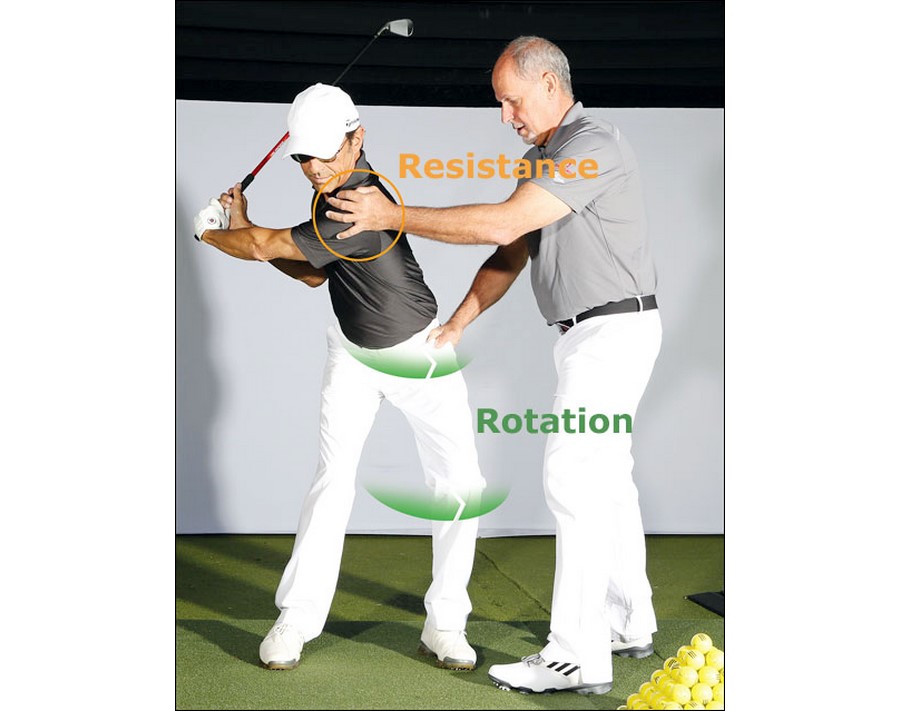
The mirror image, force and weight of the club versus the centre of gravity. You control the rotation. There is no extending the club down the line to the target, the arms and the club work inside as the body rotates.
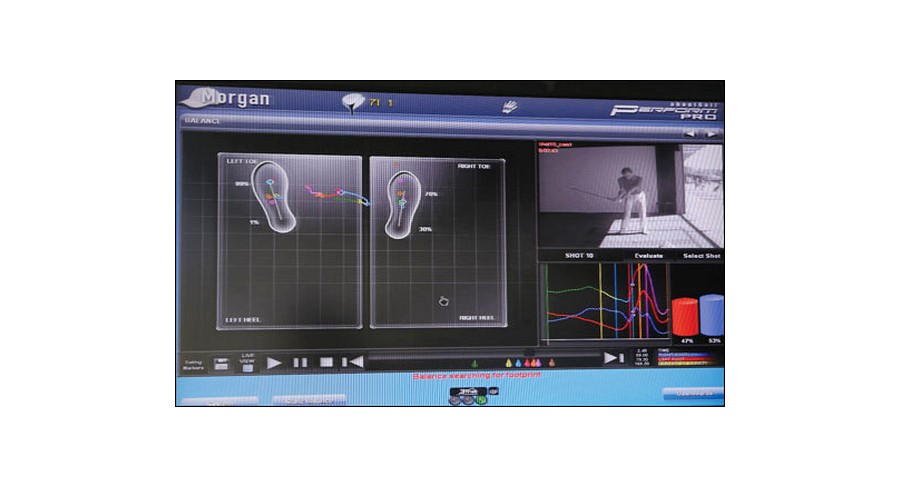
Feel the chain of command – and improve your core rotation
When we explore the dynamics of the socalled kinematic chain of energy in the golf swing, one of the key relationships (speaking for a right-handed player) is that which exists between the left shoulder and the right foot, and the drill you see Morgan rehearsing here is designed specifically to help a golfer appreciate it – and improve his or her action using it.
Taking a high-strength resistance band, we simply loop one end around the upper part of the left arm (to pull on the shoulder), hooking the other end under the heel of the right foot. The key then is to maintain the pressure on the band, not only in the course of making the backswing (the pull of the band encouraging the left shoulder to rotate under the chin) but during the early stages of the downswing, the idea being that this reminds a player to hang on the right side for a split-second as he negotiates the transition. Finally, when the energy is then released through the ball, the pull of the band re-rotates the left shoulder to a low and around-to-face-the-target finish.
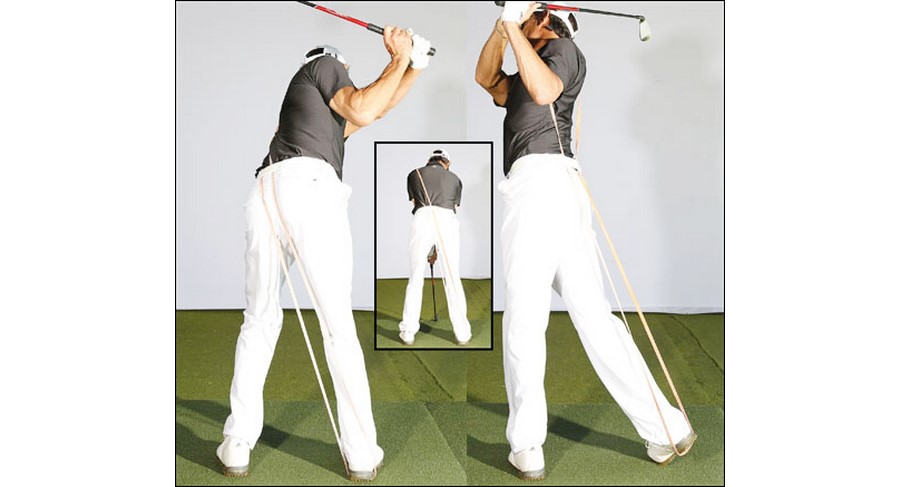
This is a drill you can use at home in the garden or out on the range, and one that will provide you with many benefits. Chief among these for many players will be the encouragement to rotate the left hip and left shoulder to a finish in the throughswing, the shoulders level, chest facing the target. Another notable plus is that the band pulls the left shoulder away from the chin in the release through the ball – that ‘separation’ being one of Nick Faldo’s favourite sensations in his heyday, and one that can only be achieved with a smooth transition.
Finally, with regular use you will be made aware of the way your weight flows down inside the axis of the right foot towards the heel on the way back, and then down that same axis into the left heel as you unwind to the finish – a mirror image which reflects perfectly the dynamic of weight shift in a good golf swing.
Stay grounded, feel ‘le crunch’
The stability you create at the set-up and work hard to maintain through the backswing must also be present at impact, the moment of truth! And one of the keys to achieving that is to feel as ‘grounded’ as you possibly can through the impact area.
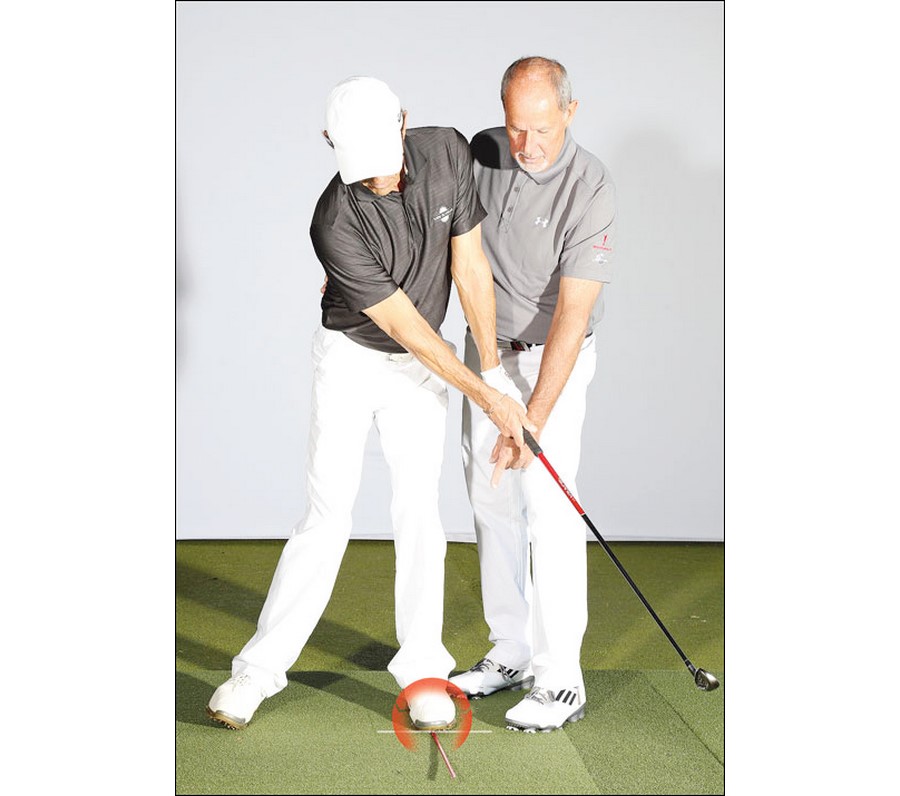
A good way to identify with this quality in your swing is to make rehearsals standing with your left foot on top of an alignment cane, and to feel that downward pressure as you repeat the motion of swinging through impact and clearing the left hip towards the finish. You have to maintain the equilibrium in the left foot, and another good way to do that is to use an empty water bottle, cut it on both sides to make it flat and place it under your left heel (as you see above). The objective then is to feel the bottle under the left foot and apply pressure on it with the heel as you arrive at the finish. This will encourage you to fully rotate your hips towards the target, thus enabling you to flow your weight along the Hendrix Bar to the heel.
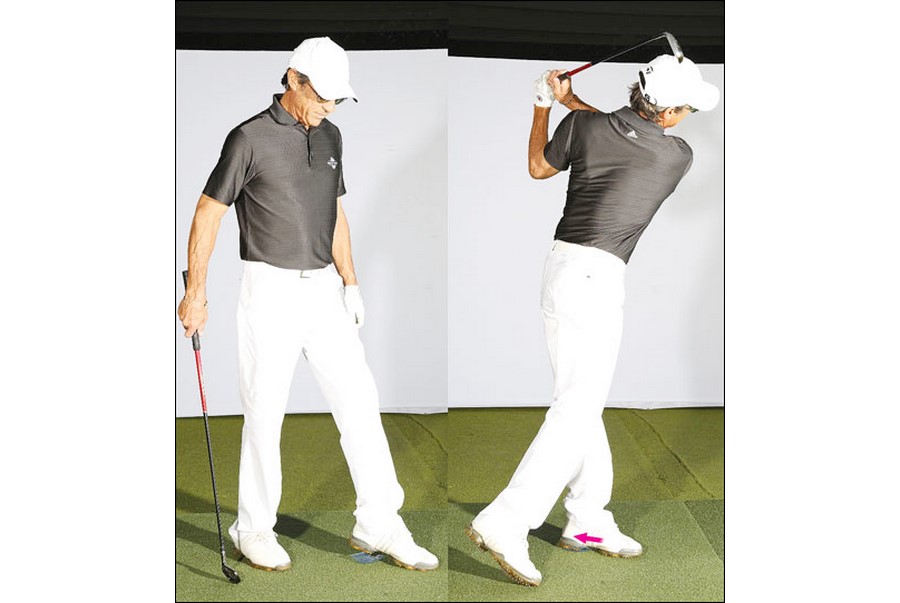
About core rotation
Another simple and yet highly effective training exercise: use a weighted medicine ball and focus on the rotation of your core over the stability of a sound foot, leg and hip action. Try to stay ‘grounded’ throughout and let your arms work in tandem with the rotation of your torso to swing the ball back and then through. To maintain that symmetry into the through-swing you actually need to throw the ball to the left of your target line. Try it, and see what new sensations you can discover…
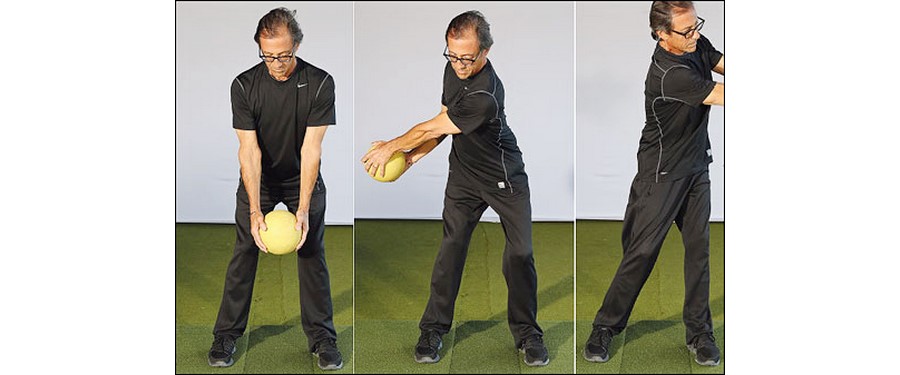
Working with the laws of physics – and loving the results
Biomechanics in golf is all about controlling the kinetic energy of the club through the working of the body. And if you look at a modern tour player – someone like our new PGA Champion Matteo Manassero, who works regularly with us on the European Tour through the ETPI unit, and here at Terre Blanche – you will see the athletic motion at the heart of the golf swing. The kinematic sequence works from the ground up, with good footwork literally drawing energy up out of the ground.
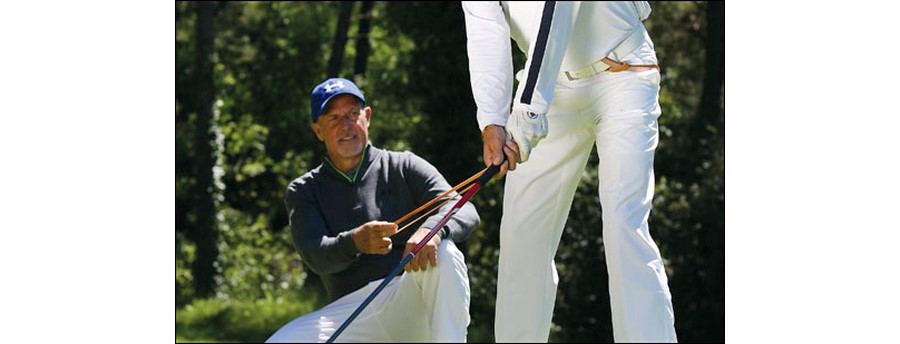
As you will have noticed, Morgan is a pretty fit and flexible guy for someone in his mid 50s. And in these photos you can see how the principles we work on in the studio, and the exercises we prescribe in the gym, gel together to give him an excellent swing dynamic; a repeatable action that produces solid shots.
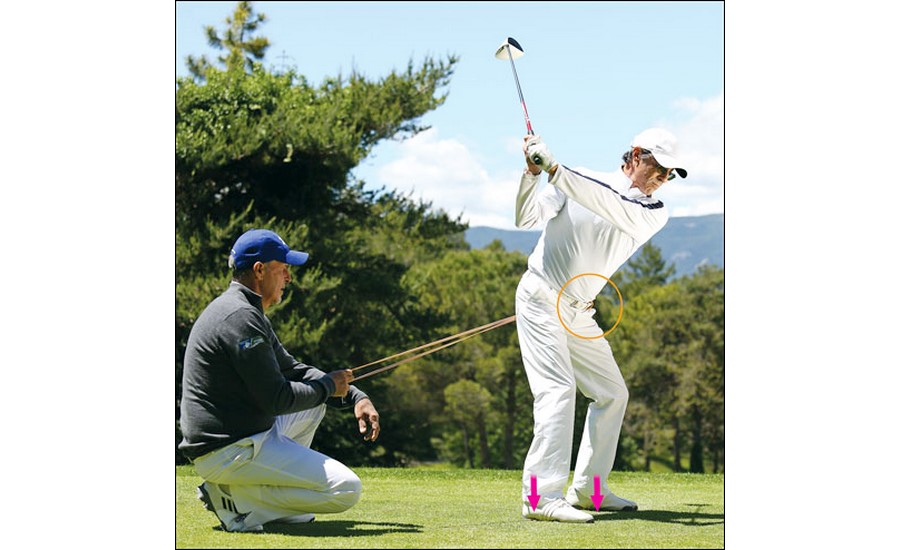
Over balanced, grounded footwork, Morgan is able to make his swing optimising his centre of gravity and the direction of his weight shift is in tune with his centre of gravity.
Here, the high-strength rubber band that I have attached to his left hip belt loop makes for a simple exercise that enables me to remind him first of the resistance that must be offered by the left hip in the early stages of the backswing, and then the re-rotation of that hip which clears the way for the downswing.
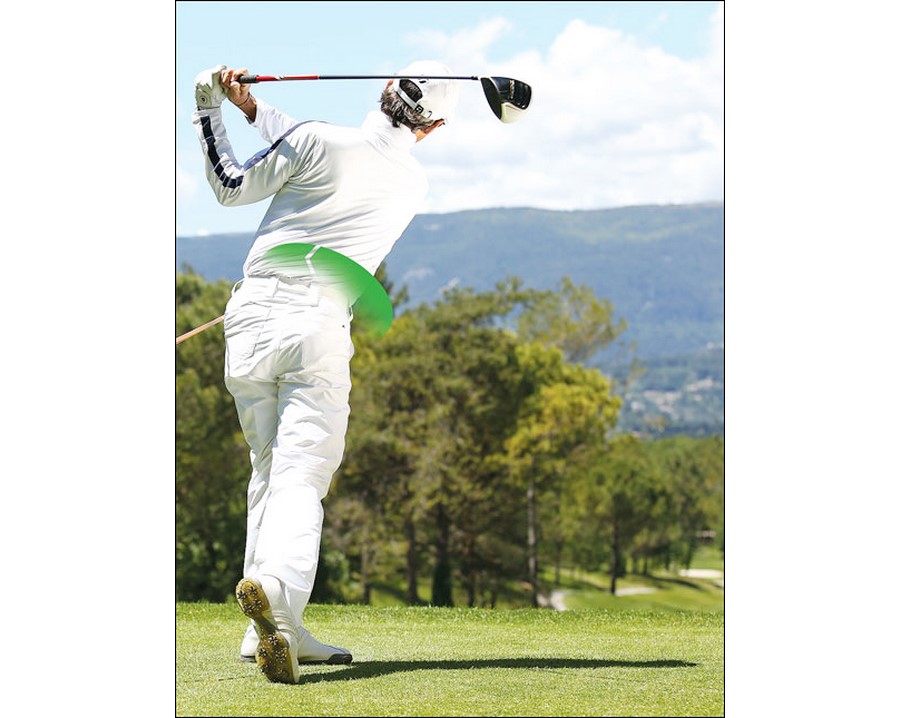
It is through this rotation that a good player generates speed via the principles of centrifugal force (and the accomplished golfer makes it all look so easy!). The body is the hub. Like the discuss thrower generating speed from within his core, so Morgan is enjoying the basic laws of physics – and repeating them!

